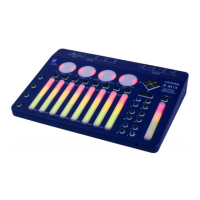K-MIX HARDWARE
72
4.3.1.1 – PORT 1: K-MIX AUDIO CONTROL
The K-Mix Audio Control port is used for controlling K-Mix’s Mix bank parameters via MIDI.
• Sending MIDI to this port from a connected computer will allow you to control things like channel
EQ settings, Compressor settings, fader levels, panning, etc. This allows you to automate your
K-Mix from a DAW or other MIDI-capable software.
4.3.1.2 – PORT 2: K-MIX EXPANDER
The K-Mix Expander port is used exclusively for receiving MIDI from and sending MIDI to a connected
MIDI Expander.
• Any MIDI sent from an external device to the Expander’s MIDI In jack will enter the computer via
this port.
• Any MIDI sent from the computer to this port will be sent out of the Expander’s MIDI Out jack.
4.3.1.3 – PORT 3: K-MIX CONTROL SURFACE
The K-Mix Control Surface port is used for receiving MIDI from and sending MIDI to K-Mix’s MIDI banks.
This is the port that audio applications should listen to in order to receive MIDI coming directly from
K-Mix.
• Any MIDI sent to this port from a connected computer will allow you to control the faders, rotaries,
and buttons in K-Mix’s MIDI banks.
• Manipulating faders, rotaries, and buttons within any of K-Mix’s MIDI banks will send MIDI from
K-Mix to a connected computer over this port.
4.3.2 – SENDING MIDI FROM K-MIX
K-Mix is able to output standard, class-compliant MIDI messages over USB and over 5-pin DIN via the
optional MIDI Expander.
4.3.2.1 – MIDI BANKS
K-Mix offers three MIDI “banks”; each fader, rotary, and button can be set to output completely different
MIDI messages for each bank. You can change the current bank by using K-Mix’s diamond pad.
FADERS
K-Mix’s faders behave like traditional sliders on MIDI controllers when in the MIDI banks.
• Each fader outputs its current location as a MIDI CC message.
• The specic CC each fader outputs is set in the K-Mix Editor’s MIDI Tab.
K-Mix does not report back its Mix bank parameters via MIDI over the K-Mix Audio
Control port; it can only receive over this port.

